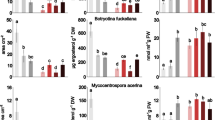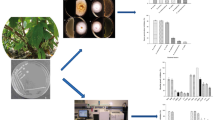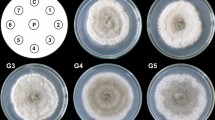Abstract
We tested the activity of 11 main compounds identified from Pinus plants on the growth of Dictyostelium discoideum NC4. Four concentrations (1, 0.1, 0.01, 0.001 μg/μl) of each compound were tested using a disk volatilization technique following germination of D. discoideum NC4 spores. Photographs of D. discoideum NC4 fruiting bodies were taken 2 days after treatment. Fenchone (at 0.1, 0.01, and 0.001 μg/μl) and camphene (at 0.01 μg/μl) stimulated growth of D. discoideum NC4. (1S)-(−)-verbenone, (1S)-(−)-α-pinene, (+)-β-pinene, myrcene, (−)-menthone, (−)-bornyl acetate, (S)-(+)-carvone, (−)-camphene, and (R)-(+)-limonene inhibit its growth. All of the compounds at 1 μg/μl had a strong inhibitory effect on cell growth of D. discoideum NC4. Microscopic observation of the fruiting bodies matched the results of growth rate analysis. Most of the inhibitory effects were represented by changes in the shapes of the fruiting bodies. These changes include short sorophores, smaller sized sori, and sori without spores. Our results suggest that inhibition of growth is the most common effect of monoterpenoids on D. discoideum NC4. Nevertheless, some of them, like fenchone and camphene, seem to enhance its growth.
Similar content being viewed by others
REFERENCES
Amaral, J. A., Ekins, A., Richards, R., and Knowles, R. 1998. Effect of selected monoterpenes on methane oxidation, denitrification, and aerobic metabolism by bacteria in pure culture. Appli. Environ. Microbiol. 64:520–525.
Cavender, J. C. 1972. Cellular slime molds in forest soils of eastern Canada. Can. J. Bot. 50:1497–1501.
Cleveland, C. C. and Yavitt, J. B. 1998. Microbial consumption of atmospheric isoprene in a temperate forest soil. Appli. Environ. Microbiol. 64:172–177.
CoÛteaux, M. M., McTiernan, K. B., Berg, B., Szuberla, D., Dardenne, P., and Bottner, P. 1998. Chemical composition and carbon mineralisation potential of Scots pine needle at different stages of decomposition. Soil Biol. Biochem. 30:583–595.
Daferera, D. J., Ziogas, B. N., and Polissiou, M. G. 2000. GC-MS analysis of essential oils from some Greek aromatic plants and their fungitoxicity on Penicillium digitatum. J. Agric. Food Chem. 48:2576–2581.
Feest, A. and Madelin, M. F. 1988. Seasonal population change of myxomycetes and associated organisms in four woodland soils. FEMS Microbiol. Ecol. 53:133–140.
Hagiwara, H. 1996. Dictyostelids in Japan. X. Two new species of Dictyostelium, D. discoideum Raper and D. robustum. Bull. Nat. Sci. Mus., Tokyo, Ser. B. 22:47–54.
Hagiwara, H. 1998. Dictyostelids in Japan XI. Dictyostelium giganteum Singh. Bull. Nat. Sci. Mus., Tokyo, Ser. B. 24:81–84.
Harborne, J. B. and Tomas-Barberan, F. A. 1991. Recent advances in the ecological chemistry of plant terpenoids, pp. 399–426, in J. B. Harborne and F. A. Tomas-Barberan (eds.). Ecological Chemistry and Biochemistry of Plant Terpenoids. Oxford University Press, Oxford.
Harder, J. and Probian, C. 1995. Microbial degradation of monoterpenes in the absence of molecular oxygen. Appli. Environ. Microbiol. 61:3804–3808.
Helander, I. M., Alakomi, H. L., Latva-Kala, K., Mattila-Sandholm, T., Pol, I., Smid, E. J., Gorris, L. G. M., and Wright, A. 1998. Characterization of the action of selected essential oil components on gram-negative bacteria. J. Agric. Food Chem. 46:3590–3595.
Hwang, J. Y., Hagiwara, H., and Kim, J. H. 2000. The occurrence and morphological comparison of Dictyostelid cellular slime molds in Mt. Muhak soils. Korean J. Ecol. 23:315–321.
Kainulainen, P. and Holopainen, J. K. 2002. Concentrations of secondary compounds in Scots pine needles at different stages of decomposition. Soil Biol. Biochem. 34:37–42.
Kang, H. N. and Kim, J. H. 1997. Monoterpenoids in Pinus thunbergii, Pinus rigida, and Pinus densiflora. Korean J. Ecol. 20:323–328. (in Korean, abstract in English)
Misra, G., Pavlostathis, S. G., Perdue, E. M., and Araujo, R. 1996. Aerobic biodegradation of slelected monoterpenes. Appl. Microbiol. Biotechnol. 45:831–838.
Oosterhaven, K., Gorris, L. G. M., and Smid, E. J. 1996. Comparative study on the action of S-(+)-carvone, in situ, on the potato storage fungi Fusarium solani var. coeruleum and F. sulphureum. J. Appl. Bacteriol. 80:535–539.
Paavolainen, L., Kitunen, V., and Smolander, A. 1998. Inhibition of nitrification in forest soil by monoterpenes. Plant Soil 205:147–154.
Schmidt, S. K., Lipson, D. A., and Raab, T. K. 2000. Effects of Willows (Salix brachycarpa) on populations of salicylate-mineralizing microorganisms in Alpine soils. J. Chem. Ecol. 26:2049–2057.
Tellez, M., Estell, R., Fredrickson, E. D., Powell, J., Wedge, D., Schrader, K., and Kobaisy, M. 2001. Extracts of Flourensia cernua (L): Volatile constituents and antifungal, antialgal, and antitermite bioactivities. J. Chem. Ecol. 27:2263–2273.
Tiiangadurai, D., Anitha, S., Pullaiah, T., Reddy, P. N., and Ramachandraiah, O. S. 2002. Essential oil constituents and in vitro antimicrobial activity of Decalepis hamiltonii roots against foodborne pathogens. J. Agric. Food Chem. 50:3147–3149.
Vokou, D., Chalkos, D., Karamanlidou, G., and Yiangou, M. 2002. Activation of soil respiration and shift of the microbial population balance in soil as a response to Lanvandula stoechas essential oil. J. Chem. Ecol. 28:755–768.
Vokou, D. and Liotiri, S. 1999. Stimulation of microbial activity by essential oils. Chemoecology 9:41–45.
Watts, D. J. and Ashworth, J. M. 1970. Growth of myxamoebae of the cellular slime mold Dictyostelium discoideum in axenic culture. Biochem. J. 119:171–174.
White, C. S. 1994. Monoterpenes: Their effects on ecosystem nutrient cycling. J. Chem. Ecol. 20:1381–1406.
Yun, K. W. and Choi, S. K. 2002. Mycorrhizal colonization and plant growth affected by aqueous extract of Artemisia princeps var. orientalis and two phenolic compounds. J. Chem. Ecol. 28:353–362.
Author information
Authors and Affiliations
Rights and permissions
About this article
Cite this article
Hwang, J.Y., Kim, J.H. & Yun, K.W. The Effect of Selected Monoterpenoids on the Cellular Slime Mold, Dictyostelium discoideum NC4. J Chem Ecol 30, 1153–1163 (2004). https://doi.org/10.1023/B:JOEC.0000030269.07833.8f
Issue Date:
DOI: https://doi.org/10.1023/B:JOEC.0000030269.07833.8f




